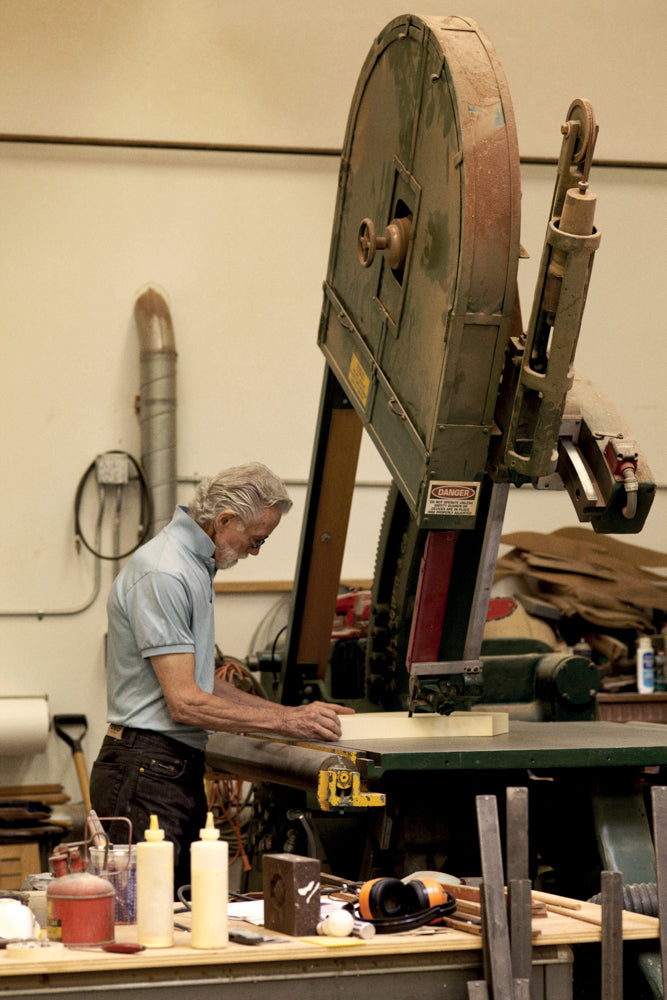
Wendell Castle
WENDELL CASTLE



Now in the sixth decade of his extraordinary career, the father producing pieces of unequaled sculptural beauty the old-fashioned of the American art furniture movement is as prolific as ever, way — with his own hands.
Wendell Castle, fighting fit at the age of 80, maintains a level of productivity that’s almost criminal. He can already look back at a career unique in its scope and degree of success: For half a century, he’s been a furniture designer, a sculptor, and an educator. Oh, and he’s widely acknowledged as the founder of the American art furniture movement. If that sounds impressive, it is.
Castle, instantly identifiable for his silver beard and custom-designed glasses, makes such a striking impression that if you don’t recognize him you feel the fault is your own. Castle is an iconoclast who let the world come to him. In retrospect, his path seems inevitable, but that doesn’t mean it was. He helped establish furniture as a form of high art, but he did it without a lot of fuss. He’s an expert of contour and balance, volume and void, and while most of his signature pieces are made of laminated wood, he also works in fiberglass, bronze, and concrete.




“Drawing is important for creating the ideas,” he says. “But then you have to realize them.”
The establishment has bestowed impeccable credentials on him: He received a lifetime achievement award from the Brooklyn Museum of Art in 2007 and has obtained several grants from the National Endowment of the Arts. His work is in permanent collections of key museums like The Metropolitan Museum of Art, the Museum of Modern Art, and London’s Victoria and Albert Museum. He’s well represented at major design fairs around the world (and their biennial and triennial iterations), and in galleries in New York.
The marketplace has also smiled upon Castle; his iconic pieces are highly coveted and fetch well into six figures at auction. He’s commissioned by high-rolling design aficionados to make custom furniture. And he’s the artist-in-residence at the School for American Crafts at the Rochester Institute of Technology, where he has taught for four decades.
How did he end up at this exalted place? A Kansas native, Castle studied industrial design and sculpture at the University of Kansas. “When I began,” he says, “furniture was viewed a number of steps below sculpture and that kept me away from it.” He overcame that reluctance, and his aim became the elevation of furniture into the category of sculpture. He moved to New York for a year, but it didn’t take. Castle remembers: “It was important to see what was shown in galleries, even if what I was doing didn’t fit in.”




At the time, Charles and Ray Eames’ smartly conceived furniture — made of plastic and plywood and easily mass-produced for an expanding audience — ruled the design world. Mass production was not what motivated Castle; his work took a long time to make and each piece was unique. He didn’t want to make an instantly recognizable chair that many people could have; he wanted to make a singular chair that enough people would want. That is not to say he’s not attuned to the needs of a broader public (he has designed a line of American-made furniture that is more widely available), but to this day, when Castle makes something he signs it.
There is a great photograph of Castle in the 1970s, bearded and wearing cowboy boots, in a deserted landscape. He sits on a wooden chair at a table of his own design; it’s an improbable situation, and yet he looks entirely at home. His early work embodied the craft movement and recalled the elemental elegance of Constantin Brâncusi, Wharton Esherick, and George Nakashima. But Castle moved beyond wood as a preferred medium. “It wasn’t long before I got over beautiful pieces of wood,” he recalls. “I could have a similar vocabulary in many different materials.”




"Castle’s superbly sculpted pieces invite a deep, personal connection."
Castle’s work demands to be approached; it inevitably has a commanding surface. Yet even the pieces constructed from industrial materials never feel manufactured; they feel built. A chair that requires months to craft is meant to be lived with and used over many years. One dealer tried to characterize the appeal of Castle: “Imagine your grandpa is a design genius who takes some Ecstasy.” That’s true as far as design genius goes. And true that some of his more biomorphic forms have an otherworldly Gaudiesque quality. But grandpa? Aside of animation. “Drawing is important for creating the ideas,” he says. “But then you have to realize them.”
Designing furniture requires a delicate balance between evolving new forms and ongoing human needs — our comfort and our daily habits. A chair doesn’t have to resemble any other chair ever made, but it should function like every other one. It’s interesting to see how that need for function asserts itself even in Castle’s most visionary designs. His Molar Chair, for instance, is so smoothly seductive you almost forget you can sit in it; the function is hidden in plain sight.





When a piece of furniture becomes valuable, that changes how it’s used, like Air Jordans that never leave the box or a bottle of Château Pétrus that’s never drunk. When collectors get involved, the basic equation is changed; you may cause a sharply raised eyebrow if you set your green tea down on a $100,000 table. But it’s not just the price tag that makes the owner protective; Castle’s superbly sculpted pieces invite a deep, personal connection. Oscar Wilde famously wrote, “All art is quite useless,” and while there is no disputing Castle’s place in the artistic pantheon, his work remains decidedly useful (though he concedes that, while his more daring chairs lack comfort, “they shouldn’t torture you”).
Castle has succeeded on his own terms. The art furniture movement asserted the primacy of furniture’s higher, transcendent possibilities; reinvigorating that creative ideal is no small accomplishment. But his work remains about more than aesthetics. In the digital age, Castle’s impact is ongoing and yet his appeal remains fundamental: He makes things, and makes them well.





